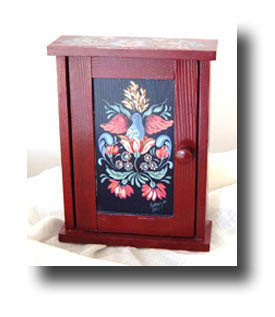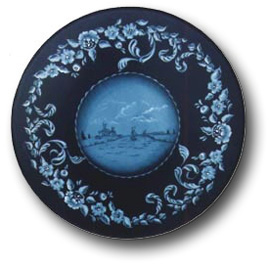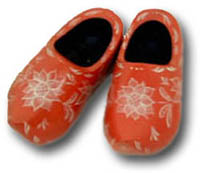Hindeloopen Hindeloopen is named after a little harbour
village in the northern province of Friesland in the Netherlands
where, at the beginning of the 17th century, woodcarving became
very popular. Features of the Folk Art of Hindeloopen The Hindeloopen style can be distinguished
by a mass of acanthus scrolls and small flowers. Favourite flowers
are daisies, poppy heads, roses, chrysanthemums and tulips. Leaves and flowers
are first stroked in using a round brush and dark colours are
then
used
as shadow
strokes representing the carved out portions of the wood. A
third stroke in a lighter colour would be painted to represent
the
embossed higher portion of the carving. Often
a "lucky bird" is featured
perched at the centre of the design amidst the flowers. This
bird is always painted looking over his shoulder to keep evil
spirits away. Faux marbling techniques are also used in
Hindeloopen and often graced the sides of items painted. 
This elaborate document box was painted
at a seminar with Sandy Aubuchon. Typical Hindeloopen colours
were used in this project and the sides of the box cover were
decorated with a marbling effect.
Origins and Development of Hindeloopen The rich favoured oak as
a status symbol and frequently had elaborately carved oak for
doors and furniture in their homes. The first painting began
at the end of the 17th century when the wood carvings were decorated
with available colours like green, blue and red. Eventually,
carving designs were painted on instead of the wood being carved. The Hindeloopen style became
very popular and folk artists there still use oil paints
to paint their designs. Typically, greens, blues and reds were
used in
painting Hindeloopen. 
Hindeloopen
in traditional colours painted on a key cupboard. The design
is based on various projects in
Sandy Aubuchon's book "Hindeloopen American Style". Many Hindeloopen designs are, however,
painted in tones of a single colour e.g. blues or browns.
Dutch sceneries
are also sometimes included in Hindeloopen designs and
are painted in a simplistic manner paying little attention to
proportion. 
Hindeloopen scrolls and flowers with a Dutch
scenery painted in three tints of blue on a carousel. Adapted
from a design by Merrell Davis. Oriental artefacts and chintzes
brought home by Dutch sailors of the 16th and 17th century also
influenced the development of Hindeloopen. Hindeloopers attempted
to imitate the porcelain pieces by painting similar designs on
wood.

During the cultural decline of the 18th
and 19th century, interest in Hindeloopen painting disappeared
and enjoyed a revival only in the late 19th century. Additional
painting techniques developed during this period, namely the Roosje
Style and the Huttinga Style. 
A pair of traditonal Dutch klompen painted
in the Huttinga style.
|